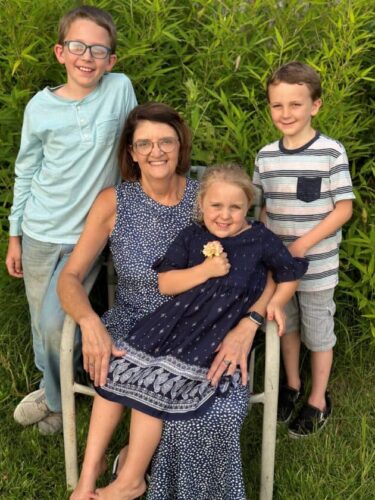Former Pediatrician Feels ‘Wonderful’ a Year and a Half after CAR T-cell Therapy at UAMS
| Wendy Bowen was just 38 years old and in her fourth year of working as a pediatrician in Jackson, Tennessee, when severe chronic fatigue forced her to retire in March 2003.
She had been diagnosed six months earlier with multiple sclerosis (MS), and it seemed to be rapidly taking its toll.
Then one morning about three years later, she awoke to a new symptom that left her puzzled: a deep ache in both of her shoulders.
“I felt like I had worked very hard the day before,” she said. But she couldn’t think of anything she had done to prompt the discomfort.
When the ache wouldn’t go away, she went to her doctor, who ordered some bloodwork that produced some “strange labs.”
Her doctor sent her to a rheumatologist, who in turn sent her to an oncologist.
By October 2006, a slew of additional tests that included a bone marrow biopsy resulted in a definitive diagnosis: multiple myeloma, a rare cancer of the plasma cells, which are cells in the bone marrow that produce antibodies. Although these white blood cells normally protect the body from germs and other harmful substances, somehow they had malfunctioned and multiplied, overproducing one particular plasma cell line.
The myeloma cells tend to collect over time in the bone marrow and in the bones, and often cause pain, fractures, fatigue, and can render the bone marrow unable to do its main job, making blood cells of all kinds. Bowen said that cancer is a known possible side effect of the immunosuppressive MS therapy she was taking.
Her diagnosis was nonetheless surprising for a 41-year-old white woman, as myeloma is much more common in people who are male, Black and between the ages of 65 and 74.
Bowen’s oncologist gave her the name of three hospitals in the region that could perform a stem-cell transplant, regarded as the gold standard for myeloma, and she chose UAMS, a 3½-hour drive away.
At the time, the youngest of her three children, a girl, was just 8 years old. Her oldest, a boy, would be graduating from high school. She said her husband, Mike — her high school sweetheart with whom she celebrated 39 years of marriage on April 14 — quickly agreed to be her caregiver, and they spent the better part of 10 months in Little Rock while she underwent myeloma treatment, including two stem-cell transplants in 2007.
Myeloma mutates to survive, forcing her to undergo a third stem-cell transplant in September 2018, which kept her in remission for about a year.
By 2021, she said, “None of the therapies were working anymore. Then I found out that CAR T-cell treatment had been approved by the FDA in March.”
She was referring to chimeric antigen receptor (CAR) T-cell immunotherapy, a new cutting-edge procedure in which patients experiencing relapsing myeloma are given infusions of their own genetically enhanced T-cells, a type of immune cell. The modified cells expand, multiply and seek out myeloma cells, and kill them.
Frits van Rhee, M.D., Ph.D., clinical director of UAMS’ Myeloma Center, has overseen her treatment from the very beginning in 2006. He was one of the few physicians, and UAMS one of the few centers in the South, allowed to perform this procedure. His staff began work immediately to perform the long list of things that have to be done to obtain ABECMA, the name of the genetically modified cells. On Nov. 15, 2021 — five months after her insurance company began covering the procedure and three months after UAMS gained approval to provide it — she became the third UAMS patient to undergo it.
“Several weeks before the treatment you have your T-cells collected using a machine much like what is used to donate plasma at a blood donation center. The cells are mailed to the drug company’s lab, where they attach a protein ‘key’ that will only attach to myeloma cells. Once your cells are ready you have a port placed, have three days of chemotherapy required to prep your bone marrow for the arrival of these ‘killer cells.’ After being admitted to UAMS, they hang the bags like any IV infusion, hook it up to your port, and infuse it. That’s it!” she said. “I think the whole thing took maybe an hour or two. Then you just wait.”
Bowen said she was feverish for a good 12 hours a day after the procedure. This reaction was fully expected to happen, and the medicine in the protocol for it was administered, and “by the third day, I felt fine.”
She was discharged on the seventh day, and on the 30th day of remaining within an hour of the hospital, as required, “My husband drove me home to Tennessee.”
Her first follow-up positron emission tomography (PET) scan a few months later at UAMS showed no sign of the myeloma and her bone marrow showed no plasma cells, indicating that the CAR T-cell therapy was working.
A year and a half later, at age 58, she appears to be free of both myeloma and MS.
“I feel wonderful,” Bowen said. “I haven’t felt this good since before I was diagnosed with MS. I just feel like myself again.”
She loves that no follow-up treatments are needed, and said she enjoys spending time with her grandchildren and catching up on home projects.
“I can’t imagine getting any better care than I got at UAMS,” she said. “They have great doctors, but it’s not just the doctors. The whole team at the Myeloma Center at UAMS is wonderful. This is what they do. The environment is so myeloma-friendly. You know you can trust them.”
